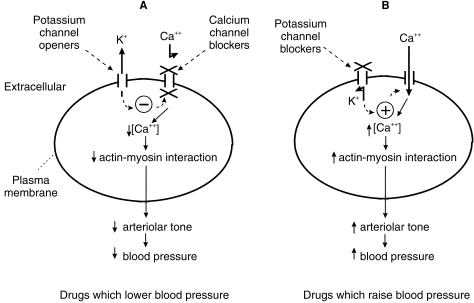Figure 5.

Pharmacological agents which modify blood pressure through actions on vascular smooth muscle cell membrane ion channels.A – Drugs which lower blood pressure. Potassium channel openers (e.g. pinacidil) open ATP-sensitive K+ channels and increase diffusion of K+ out of the cell. K+ efflux hyperpolarizes the cell membrane which triggers closure of voltage-gated calcium channels and a fall in intracellular Ca++ concentration. Ca++ channel blockers (e.g. Nifedipine, diltiazem, verapamil) block voltage-gated Ca++ channels directly, thus also reducing intracellular Ca++. A fall in intracellular Ca++ reduces the interaction between actin and myosin, lowers arteriolar smooth muscle tone and hence causes a fall in blood pressure. B – Drugs which raise blood pressure. Drugs which block ATP-sensitive K+ channels (e.g. glibenclamide) reduce K+ efflux from the cell which results in depolarization of the cell membrane and triggers opening of voltage-gated Ca++ channels. Ca++ influx through these channels increases intracellular Ca++ which in turn promotes actin–myosin interactions and an increase in arteriolar tone. K+ channel blocking agents may have a role in the treatment of hypotension in septic or haemorrhagic shock.
